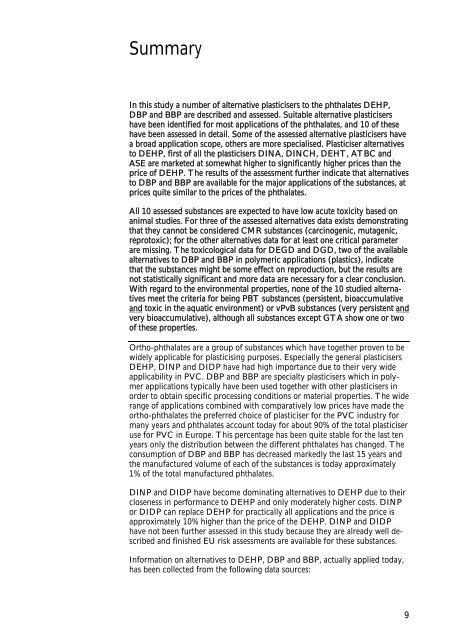Identification and assessment of alternatives to selected phthalates
Identification and assessment of alternatives to selected phthalates
Identification and assessment of alternatives to selected phthalates
Create successful ePaper yourself
Turn your PDF publications into a flip-book with our unique Google optimized e-Paper software.
Summary<br />
In this study a number <strong>of</strong> alternative plasticisers <strong>to</strong> the <strong>phthalates</strong> DEHP,<br />
DBP <strong>and</strong> BBP are described <strong>and</strong> assessed. Suitable alternative plasticisers<br />
have been identified for most applications <strong>of</strong> the <strong>phthalates</strong>, <strong>and</strong> 10 <strong>of</strong> these<br />
have been assessed in detail. Some <strong>of</strong> the assessed alternative plasticisers have<br />
a broad application scope, others are more specialised. Plasticiser <strong>alternatives</strong><br />
<strong>to</strong> DEHP, first <strong>of</strong> all the plasticisers DINA, DINCH, DEHT, ATBC <strong>and</strong><br />
ASE are marketed at somewhat higher <strong>to</strong> significantly higher prices than the<br />
price <strong>of</strong> DEHP. The results <strong>of</strong> the <strong>assessment</strong> further indicate that <strong>alternatives</strong><br />
<strong>to</strong> DBP <strong>and</strong> BBP are available for the major applications <strong>of</strong> the substances, at<br />
prices quite similar <strong>to</strong> the prices <strong>of</strong> the <strong>phthalates</strong>.<br />
All 10 assessed substances are expected <strong>to</strong> have low acute <strong>to</strong>xicity based on<br />
animal studies. For three <strong>of</strong> the assessed <strong>alternatives</strong> data exists demonstrating<br />
that they cannot be considered CMR substances (carcinogenic, mutagenic,<br />
repro<strong>to</strong>xic); for the other <strong>alternatives</strong> data for at least one critical parameter<br />
are missing. The <strong>to</strong>xicological data for DEGD <strong>and</strong> DGD, two <strong>of</strong> the available<br />
<strong>alternatives</strong> <strong>to</strong> DBP <strong>and</strong> BBP in polymeric applications (plastics), indicate<br />
that the substances might be some effect on reproduction, but the results are<br />
not statistically significant <strong>and</strong> more data are necessary for a clear conclusion.<br />
With regard <strong>to</strong> the environmental properties, none <strong>of</strong> the 10 studied <strong>alternatives</strong><br />
meet the criteria for being PBT substances (persistent, bioaccumulative<br />
<strong>and</strong> <strong>to</strong>xic in the aquatic environment) or vPvB substances (very persistent <strong>and</strong><br />
very bioaccumulative), although all substances except GTA show one or two<br />
<strong>of</strong> these properties.<br />
Ortho-<strong>phthalates</strong> are a group <strong>of</strong> substances which have <strong>to</strong>gether proven <strong>to</strong> be<br />
widely applicable for plasticising purposes. Especially the general plasticisers<br />
DEHP, DINP <strong>and</strong> DIDP have had high importance due <strong>to</strong> their very wide<br />
applicability in PVC. DBP <strong>and</strong> BBP are specialty plasticisers which in polymer<br />
applications typically have been used <strong>to</strong>gether with other plasticisers in<br />
order <strong>to</strong> obtain specific processing conditions or material properties. The wide<br />
range <strong>of</strong> applications combined with comparatively low prices have made the<br />
ortho-<strong>phthalates</strong> the preferred choice <strong>of</strong> plasticiser for the PVC industry for<br />
many years <strong>and</strong> <strong>phthalates</strong> account <strong>to</strong>day for about 90% <strong>of</strong> the <strong>to</strong>tal plasticiser<br />
use for PVC in Europe. This percentage has been quite stable for the last ten<br />
years only the distribution between the different <strong>phthalates</strong> has changed. The<br />
consumption <strong>of</strong> DBP <strong>and</strong> BBP has decreased markedly the last 15 years <strong>and</strong><br />
the manufactured volume <strong>of</strong> each <strong>of</strong> the substances is <strong>to</strong>day approximately<br />
1% <strong>of</strong> the <strong>to</strong>tal manufactured <strong>phthalates</strong>.<br />
DINP <strong>and</strong> DIDP have become dominating <strong>alternatives</strong> <strong>to</strong> DEHP due <strong>to</strong> their<br />
closeness in performance <strong>to</strong> DEHP <strong>and</strong> only moderately higher costs. DINP<br />
or DIDP can replace DEHP for practically all applications <strong>and</strong> the price is<br />
approximately 10% higher than the price <strong>of</strong> the DEHP. DINP <strong>and</strong> DIDP<br />
have not been further assessed in this study because they are already well described<br />
<strong>and</strong> finished EU risk <strong>assessment</strong>s are available for these substances.<br />
Information on <strong>alternatives</strong> <strong>to</strong> DEHP, DBP <strong>and</strong> BBP, actually applied <strong>to</strong>day,<br />
has been collected from the following data sources:<br />
9

















